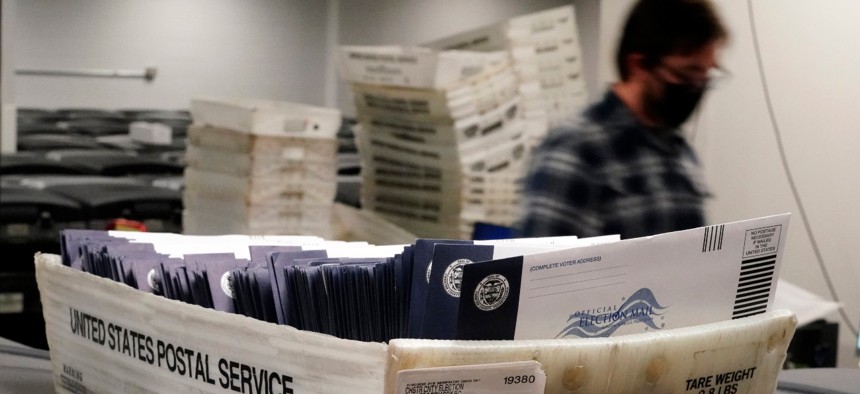
Michael Imms, with Chester County Voter Services, sorts mail-in ballots on Oct. 23 for the 2020 general election. Matt Slocum / AP
Despite Struggling With Widespread Mail Delays, USPS Is Processing More Ballots On Time
The Postal Service is processing election mail faster than mail writ large.
The U.S. Postal Service is struggling to deliver mail on time following reforms by its new chief executive, according to new data from the agency, but in recent weeks has improved its performance for processing of mailed ballots.
USPS ramped up the measures it has taken to ensure election mail is delivered in a timely fashion in the final stretch before Election Day on Nov. 3, in part due to a series of court orders requiring the actions. The mailing agency has committed a slew of additional resources specifically aimed at ballots, including increased overtime, additional trips, expediting election mail for delivery and new processes each day to flag the specially marked mail.
For now, the efforts appear to be paying dividends: for the week Oct. 16, USPS processed 96% of in-bound ballots and 97% of outbound ballots on time. That is up from 87% and 94%, respectively, one month prior and marks a fairly consistent rise, according to data USPS made public in a recent court filing. Postal management cautioned it was only able to track election mail specifically marked as such and therefore it did not include all ballots working their way from election boards to voters and back. The data also measured the timeliness of processing only within the USPS network rather than delivery to the mail pieces’ final destinations.
USPS said as of last week it had processed 100 million ballots following an unprecedented surge in absentee voting due to the novel coronavirus pandemic.
Overall, the Postal Service’s on-time delivery remains far below the levels it saw over the summer before Postmaster General Louis DeJoy’s reform initiatives went into place. Several federal judges have issued preliminary injunctions on those changes, requiring USPS to lift restrictions on late and extra delivery trips between different parts of its network. The data show those trips, which DeJoy said were costly and unnecessary but once restricted led to significant mail delays, have ticked up since the court orders went into effect but remain below pre-DeJoy levels. USPS delivered just 86% of First-Class mail on time in the week ending Oct. 16, down from around 91% in the weeks prior to DeJoy's reforms.
As part of the court orders, USPS agreed to prioritize election mail and, starting Monday, committed to expedited hiring, extra deliveries and special pickups. It has also implemented an “all-clear process” in which local staff use a checklist to confirm election mail scheduled to go out each day actually did go out or anything left behind because it came in too late is “at the front of the line” for delivery the following day. Compliance with the all-clear requirements dropped significantly in the week ending Oct. 16, according to the most recent data. Plants across the Postal Service’s 12 regional divisions averaged a 91% compliance rate—down from 96% the week before—meaning the plants either did not clear all election mail or did not make a report to headquarters 9% of the time. At the post office level, the compliance rate fell from more than 99% to 90%.
“If a facility submits no ‘all clear’ response on a given day, USPS headquarters alerts the relevant district manager or division director to follow up,” the Postal Service said in its filing. “If a particular facility exhibits a pattern of non-responses, USPS may take a corrective action.”
A USPS spokesman declined to comment on the trends in election mail data.
Last week, Kristin Seaver, USPS’ chief retail and delivery officer, told reporters the Postal Service was still looking to improve and stabilize service “across the enterprise.” The delay writ large, she said, would not impact the timely delivery of ballots.
“Election mail will not be delayed,” Seaver said. “We are committing all available resources.”
Lawmakers and advocacy groups remain concerned about the potential impact that widespread delays will have on the delivery of mail ballots. Delays are particularly prevalent in many key swing states.
“It is unacceptable that on-time mail delivery has not been restored to levels prior to the postmaster general carelessly instituting his disastrous operational changes,” said Sen. Gary Peters, D-Mich., the top Democrat on the Homeland Security and Governmental Affairs Committee. He added he will work to ensure those in his home state and across the country “can once again rely on the Postal Service not only through the pandemic and the election, but for years to come.”







